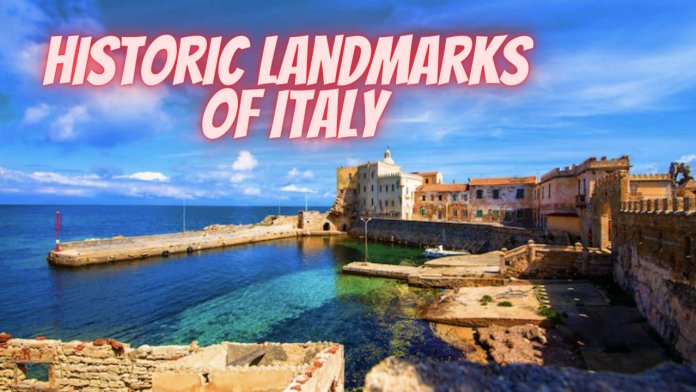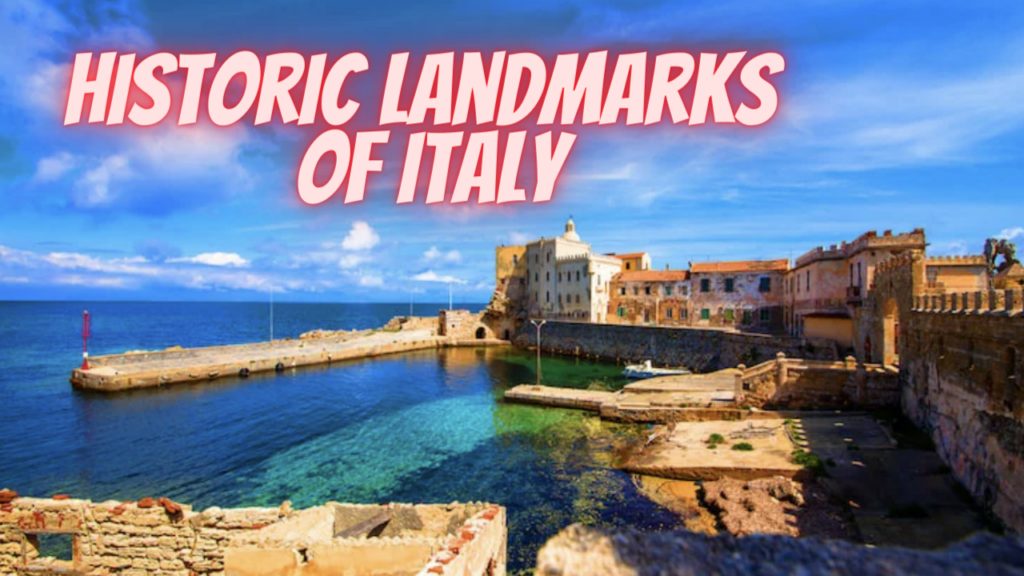It’s likely that when you think of Italy, its past comes to mind. It should come as little surprise that Italy has been continuously inhabited for so long given the country’s abundance of significant historical landmarks. As UNESCO World Heritage Sites, anything from mediaeval castles and communities to Renaissance churches and ancient Greek and Roman temples. There must be time set aside for historical tourism while visiting Italy, but where should you start? Our finest recommendations for Italy’s historical sites are included in this guide.
Must Visit Historic Landmarks of Italy City

Herculaneum
While Herculaneum was the second city to be submerged by Mount Vesuvius’ ashes in 79 A.D., while you’re certainly familiar with Pompeii, you might not be. Herculaneum is more preserved than its better-known sibling, although being smaller. When Pompeii was invaded, the inhabitants had little time to flee, leaving a large number of bodies that have been preserved here for thousands of years.
Roman Arena
Verona, a charming city in northern Italy, is famous for being the setting for Shakespeare’s Romeo and Juliet, but it also boasts one of Italy’s most magnificent Roman amphitheatres. Only 15,000 people can fit within the enormous, surprisingly undamaged arena from 2000 B.C. due to earthquake damage in 117. It continues to host events today, most notably an annual opera festival in the summer.
Grand Canal
One of the most widely recognised rivers in the world, the Grand Canal, was probably constructed along the course of an earlier river that drains into the Lagoon of Venice. Large aristocratic residences progressively took the place of the stilted homes and warehouses that once bordered the canal as the Republic of Venice developed through trade. Currently, each side of the canal is lined with more than 170 buildings, the most of which date from the 13th through the 18th century. The canal is crossed by four bridges, the most well-known of which being the charming Rialto Bridge.
Florence Cathedral
The fourth-largest cathedral in the world is Florence’s Cathedral, formerly known as the Cattedrale di Santa Maria del Fiore in honour of that saint. On top of the previous Santa Reparata basilica (remains of which may still be seen in the crypt), construction on this magnificent Gothic cathedral started in the closing years of the 13th century. After adding the large and famed dome, the project was eventually deemed complete more than two centuries after work first began.
Pianosa Island
The island of Pianosa is a distant memory. Due to conservation efforts, only 400 people can visit each day. If you have the chance, take advantage of it! Since the late Stone Age, Pianosa has been inhabited multiple times, however it is currently all but deserted. There dwell a few people as well as the island’s notable animals. A Roman town and several fishing settlements previously existed in Pianosa. The island was frequented by Napoleon, pirates, and military fortifications. When the jail closed in 1998, some paroled inmates who were living on the island kept the tourist restaurant and museum running.
Duomo di Milano
Its most popular attraction is Milan’s largest gothic cathedral, which can accommodate 40,000 visitors. Gian Galeazzo Visconti began modernising the neighbourhood in 1386 after assuming control. It took five centuries to complete the masterpiece. Its Gothic-Romanesque structure was the result of the work of numerous architects, artisans, and sculptors. The Duomo di Milano’s white and pink marble is overshadowed by the openwork pinnacles and spires of the roof. You can go over to the roof terrace as a tourist and take in the best artwork and views of the city.
St. Mark’s Basilica
Beautiful Venice is famed for its serpentine canals, stunning bridges, and spectacular architecture. St. Mark’s Basilica is one of the most well-known locations in this beautiful city. A cathedral with amazing architecture and exquisite mosaics is called About St. Mark’s Basilica. Admire the mosaics as you stroll inside the cathedral; they were created over an 800-year span, primarily with gold. Wander through with St. Mark’s Basilica Tickets for more than 500 columns as you explore the five domes and fall in love with its historical artwork. Why are you holding out? Visit and discover this amazing, more than a thousand-year-old basilica!
Basilica of San Vitale
For a while, Ravenna served as the capital of the Western Roman Empire despite sometimes being eclipsed by its busy, canal-laced neighbour to the north. As a result, it was embellished with magnificent churches, with the Basilica of San Vitale standing out as the most notable. The interior of this sixth-century structure is almost entirely decorated with mosaics that depict several biblical stories. Eight additional Ravenna structures, including the octagonal basilica, have been given the UNESCO World Heritage designation.
Cinque Terre
The five towns of the Cinque Terre are a gem of the Italian Riviera and among of Italy’s most picturesque seaside towns. They qualify as a landmark since they are all considered to be part of the UNESCO World Heritage. Starting around 100 kilometres south of Genoa, the colourful houses of the towns that make up the “Five Lands” cling impressively to bays along the Mediterranean. The attractiveness of the towns, which are connected by hiking trails and a highly packed train line, is best experienced by boat or during off-peak seasons in the spring or fall.






![Vanjangi Hill Station – Newly Discovered Attraction [Travel Guide] Vanjangi Hill Station](https://cdn.talesofbackpacker.com/wp-content/uploads/2022/11/Vanjangi-Hill-Station-100x70.jpg?strip=all&lossy=1&quality=92&webp=90&avif=90&ssl=1)

